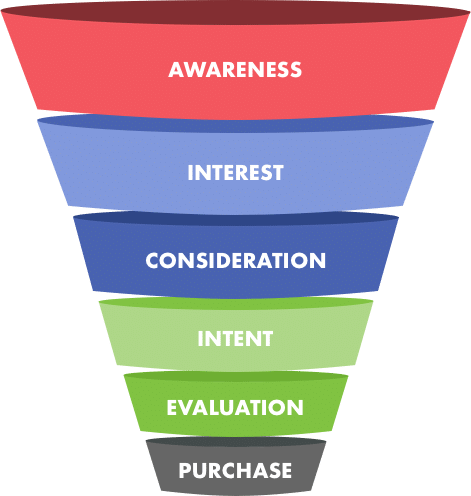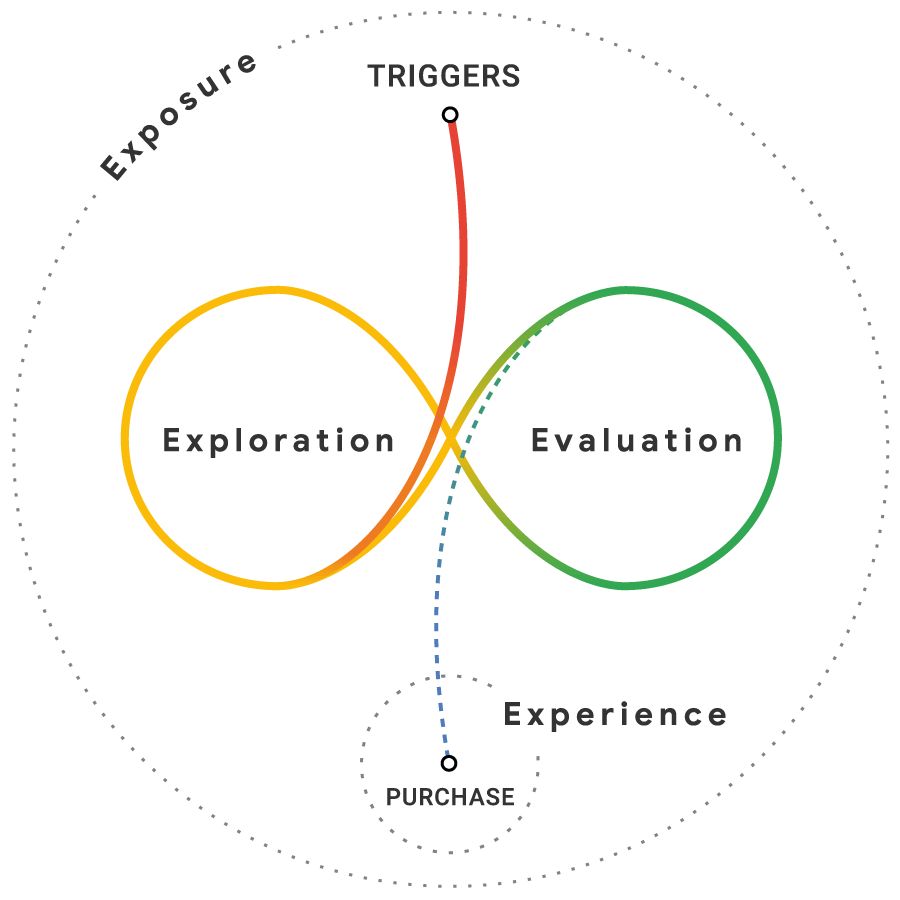The length and nature of online journeys from an initial trigger to product purchase can vary considerably. But many marketers ignore a large number of prime prospects whose journeys don’t take the textbook path, sacrificing a potentially large contributor to profitable acquisition.
In the ‘happy’ scenario, the user’s journey is fast and efficient in finding the answer or solution they are seeking. But in many categories, the ‘happy’ scenario is not the norm, and users take a longer and more complicated journey to reach a purchase decision.
The Messy Middle
Marketing funnels give the impression of sequential progress through stages of awareness, interest, evaluation and ultimately to purchase. The reality is not always as neat, as described in Google’s appropriately named “Messy Middle” model.
 |  |
The Path to Purchase: The Traditional Marketing Funnel vs Google’s “Messy Middle” Model
We have all experienced this messy middle as consumers. We become aware of, say, a new phone brand, not through awareness campaigns as marketing textbooks would describe, but because of an excited ‘review’ – really just a ? emoji with a link – on Whatsapp from a friend who has fallen in love with their new phone. From there, we might jump straight into exploring detailed product features, by clicking on the link and later, examining the friend’s phone in person.
A bit of casual research on the brand’s website and a quick skim through some influencer reviews might be followed by a period of dormancy when we forget all about new phones, and get caught up in the details of our busy life. Our current phone is working just fine, and the new candidate is out-of-sight and out-of-mind.
A couple of months later, a cracked phone screen reinvigorates the purchase journey, and off we go again – searching, probing, comparing and deliberating and finally, after a few months in the messy middle, we go ahead and make the purchase.
Are you paying attention to your messy middle customers? They may be hanging out in pools
Chris O’ Donnel of Hubspot describes fast converting customers as akin to flowing ‘rivers’, and those spending longer time in the messy middle as relatively static ‘pools’. While he sees businesses as either primarily river businesses or pool businesses, in my view the customer acquisition approach for most brands should contain a mix of river and pool strategies, as most businesses have both kinds of buyers – the quick as well as the deliberate.
Having been trained to think of funnels, most digital marketers spend disproportionate time swimming in rivers. Rivers are easier to manage as they flow in one direction, which makes it easy to design sequential experiences and track user movement and drop-offs. Often, marketers’ only nod to non-linear paths will be to run remarketing campaigns to entice customers back into the funnel, or to send abandoned cart messages.
But it is a mistake to neglect the pools of prospects who take longer to make a decision. Each of these pools corresponds to a different set of customer needs. One may comprise the budget conscious who spend time price comparing and waiting for a discount. Another pool of prospects may want to research every detail and have a high degree of confidence in their decision before they purchase. Yet others, as in our example above, may simply be casual browsers, who buy only when the appropriate trigger prods them to act.

Is a focus on rivers leading you to ignore large pools of prospective customers?
Getting pools to rejoin the river
Phil Collins says “you can’t hurry love”. You can’t hurry these pools of prospects into buying either. But like an experienced sales hand, you can stay in touch, with a focus on conversation, rather than conversion.
This is exactly what Flintobox, a childrens’ activity box subscription service, did. As background, the company’s boxes help kids learn through fun, hands-on activities, and get them away from the temptations of screen time or ennui of boredom.
After initially failing to convert unready-to-buy parents with upfront offers, Flintobox used an online quiz to categorise these parents into distinct pools based on their child-rearing related concerns.
Each pool of customers was then engaged through an extended online conversation that was specific to their problem. With one pool of parents, Flintobox’s conversation focused on the problem of excess screen time. With others, it was about kids with an apparent attention deficit, or the lack of quality time spent together with kids.
Each conversation, using articles and videos, discussed possible solutions to the parents’ problem. Flintobox was careful to not hard-sell their own solution as the definitive answer, but rather as one of a few possible answers.
Over time, these content-based engagements led to a growth in trust, while keeping Flintobox front-of-mind for parents. Flintobox then provided a trigger, in the form of a time-bound offer, to get the parents to convert to purchase.
With this conversational, patient and targeted approach for each pool of prospects, Flintobox was able to grow its customer base dramatically, while holding its cost of acquisition steady.
Go on, take a swim in the pool
Just as it is less expensive to sell to an existing customer than a new one, it is a shame to ignore the pools of potential customers on whom you have already expended time and effort, who have already engaged with your brand and proposition, and most of whom are more qualified prospects than the average internet user out there.
Why take too many expensive fishing trips in the larger internet ocean, when you have pools of interested customers ready to engage with you? Give them some patient and targeted attention, and you will likely be rewarded with faster growth at lower costs.



